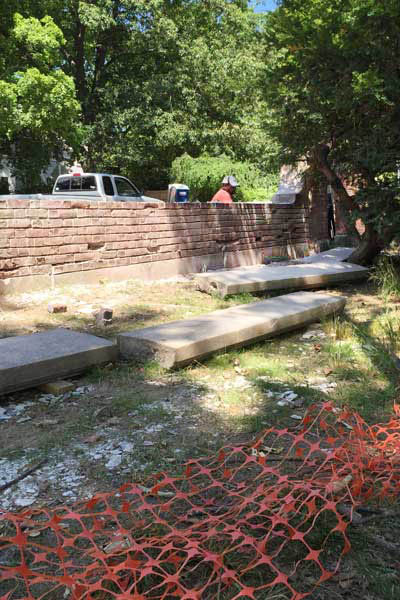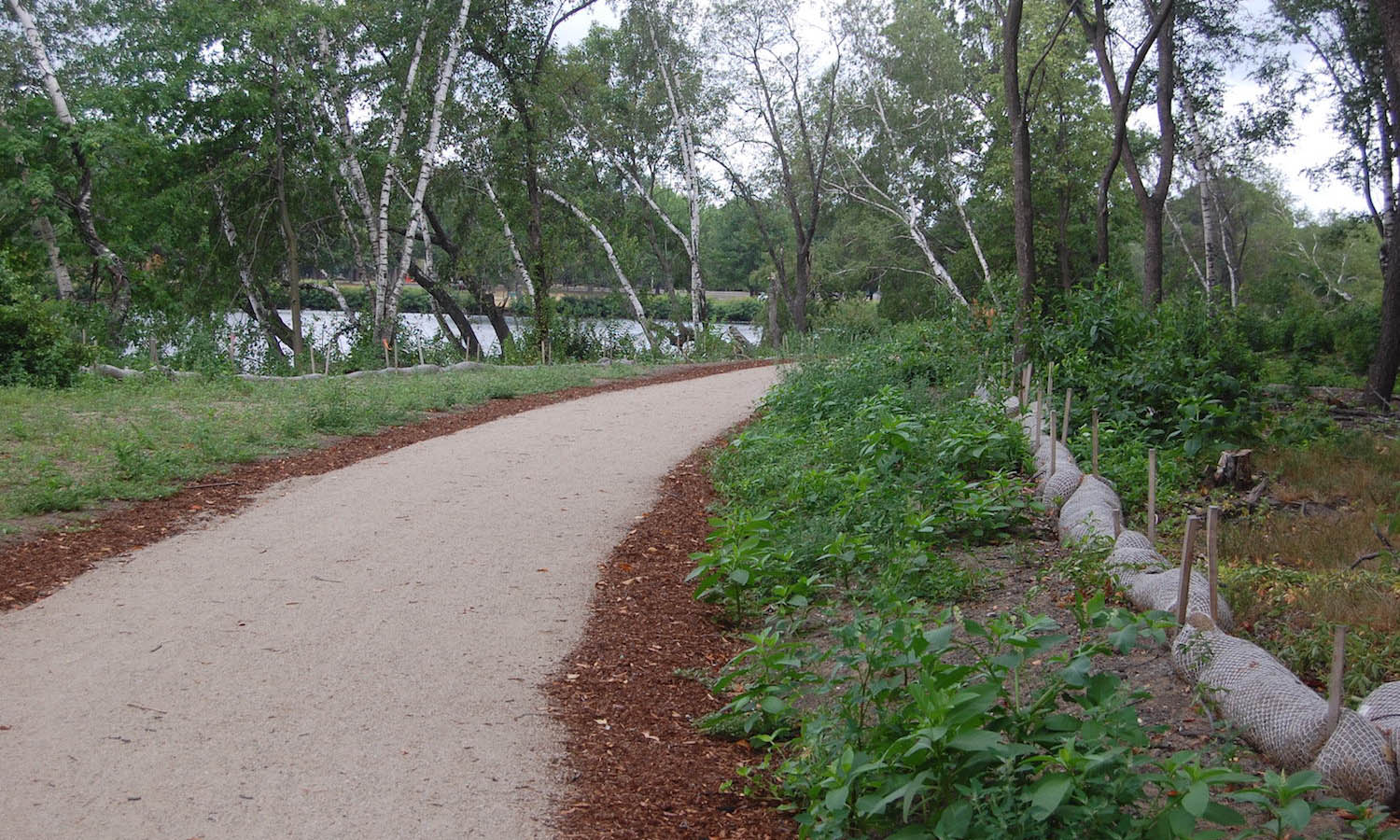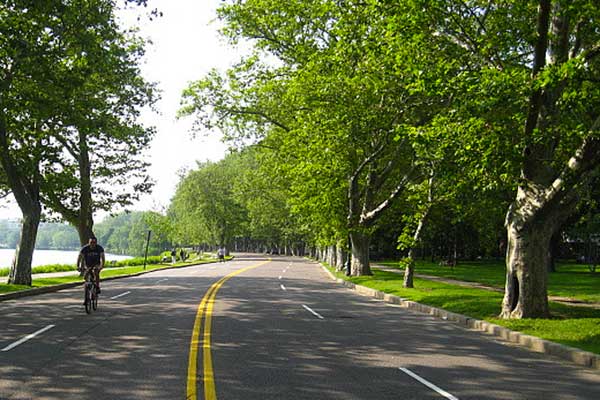Lowell Memorial Park
 The club’s interest in this site goes back to the early 1900s when members advocated for the creation of a park on grounds that once belonged to a pre-Revolutionary War mansion, the longtime home of notable Cantabrigian James Russell Lowell. In 2012, CP&GC members reached out to the DCR in hopes of planting a linden tree at the park. The park had long been overdue for restoration, especially the historic brick wall and along Brattle and Mount Auburn Streets. The DCR commissioned a report identifying preservation priorities, and CP&GC applied to the Cambridge Community Preservation Act Committee and DCR’s Partnership Matching grant program for funding—funding was allocated and encouraged by CP&GC’s interest. DCR has completed a cultural landscape assessment of the site and has worked to renovate the brick wall that defines two borders of the green space.
The club’s interest in this site goes back to the early 1900s when members advocated for the creation of a park on grounds that once belonged to a pre-Revolutionary War mansion, the longtime home of notable Cantabrigian James Russell Lowell. In 2012, CP&GC members reached out to the DCR in hopes of planting a linden tree at the park. The park had long been overdue for restoration, especially the historic brick wall and along Brattle and Mount Auburn Streets. The DCR commissioned a report identifying preservation priorities, and CP&GC applied to the Cambridge Community Preservation Act Committee and DCR’s Partnership Matching grant program for funding—funding was allocated and encouraged by CP&GC’s interest. DCR has completed a cultural landscape assessment of the site and has worked to renovate the brick wall that defines two borders of the green space.
The DCR is now seeking public input for the next phase of the project, starting with approval of a design plan for the park. Quoting from the DRC website, Lowell Memorial Park “has benefitted from technical support and advocacy provided by the Cambridge Plant & Garden Club.” Club members will be able to weigh in with their individual preferences as this long-term project moves forward.
Hell’s Half Acre and Greenough Boulevard
 CP&GC’s interest in Hell’s Half Acre and Greenough Boulevard dates to the 1950s when the Plant Club opposed the building of a highway through this rare urban wilderness. The last remaining piece of marsh in the Charles River Basin, Hell’s Half Acre is now 71⁄2 acres of urban wildland owned by the DCR. It is comprised of four distinct habitat types of wetland, woodland, riparian, and road’s edge. The wetland and woodland areas are losing the battle against many unwanted invasive plants including the tenaciously invasive phragmites. In 2017, CP&GC commissioned the New England Wild Flower Society (now Native Plant Trust) to undertake a three-season botanical inventory of the site, one we hope will inform the City of Cambridge and the DCR as they move forward on reclamation plans.
CP&GC’s interest in Hell’s Half Acre and Greenough Boulevard dates to the 1950s when the Plant Club opposed the building of a highway through this rare urban wilderness. The last remaining piece of marsh in the Charles River Basin, Hell’s Half Acre is now 71⁄2 acres of urban wildland owned by the DCR. It is comprised of four distinct habitat types of wetland, woodland, riparian, and road’s edge. The wetland and woodland areas are losing the battle against many unwanted invasive plants including the tenaciously invasive phragmites. In 2017, CP&GC commissioned the New England Wild Flower Society (now Native Plant Trust) to undertake a three-season botanical inventory of the site, one we hope will inform the City of Cambridge and the DCR as they move forward on reclamation plans.
A three-year ecological restoration project to remove the invasive plants that currently choke the site will soon begin in the spring of 2020. The $150,000+ project is being spearheaded by the Charles River Conservancy, with major support by the City of Cambridge and the DRC, along with small private donations.
Read moreIn 2012, the Lawrence and Lillian Solomon Foundation, a private foundation in Greater Boston that works to enhance greenways and public parks, proposed rehabilitating land along Greenough Boulevard. On the Charles River between the Eliot Bridge and the Arsenal Street Bridge, this prominent parcel was greatly improved by providing additional and safer recreational opportunities, beautifying a significant portion of river (including the finish line for the Head of the Charles Regatta) and improving environmental quality.
In 2014, the project got underway funded jointly by the Massachusetts DCR, the Foundation and private funding.
Current members saw an opportunity to support the Foundation’s efforts in a more concrete way by being supportive of their request for City of Cambridge Community Preservation Act funding. As the mitigation work to Hell’s Half Acre is consistent with hopes and goals of CP&GC for over 50 years, we were pleased that funds were granted and this portion of the project was undertaken. Members continue to be involved in the Greenway rehabilitation and we hope to contribute additional hands-on effort at this important site.
Magazine Beach
 In 2016, CP&GC hosted an informational meeting about the developing restoration project at the city’s second largest park. On Memorial Drive and enjoyed by generations of Cantabrigians, the park has a robust group of supporters in Magazine Beach Partners. We are proud that Cathie Zusy, the organization’s president, is a CP&GC member. Since the original 2016 meeting, CP&GC has supported restoration efforts at the park in multiple ways, including digging and transplanting native perennials donated by Meadowscaping for Biodiversity in Waltham, and supplying a bicolor oak tree for inclusion in the revitalized Charles River shoreline. Across the river form Magazine Beach Park, CP&GC remains involved in following the ongoing MassDOT project to move and rebuild an I-90 Allston viaduct of the Massachusetts Turnpike and Soldiers Field Road. Photo courtesy Magazine Beach Partners
In 2016, CP&GC hosted an informational meeting about the developing restoration project at the city’s second largest park. On Memorial Drive and enjoyed by generations of Cantabrigians, the park has a robust group of supporters in Magazine Beach Partners. We are proud that Cathie Zusy, the organization’s president, is a CP&GC member. Since the original 2016 meeting, CP&GC has supported restoration efforts at the park in multiple ways, including digging and transplanting native perennials donated by Meadowscaping for Biodiversity in Waltham, and supplying a bicolor oak tree for inclusion in the revitalized Charles River shoreline. Across the river form Magazine Beach Park, CP&GC remains involved in following the ongoing MassDOT project to move and rebuild an I-90 Allston viaduct of the Massachusetts Turnpike and Soldiers Field Road. Photo courtesy Magazine Beach Partners
Memorial Drive London Plane Trees
 The London Plane Trees lining Memorial Drive along the Charles River have survived and prospered, defying difficult environmental conditions and remain one of the City’s most iconic symbols. These trees were chosen to line the parkway and planting began in 1897. In the early 1960s the Massachusetts Legislature proposed a highway interchange project which proposed to widen Memorial Drive, add underpasses, and cut down the London Plane trees. This met immediate resistance after quickly catching the community’s attention. Following the well-organized protest and national publicity, the plans to build the underpass and interchange were abandoned in 1972. Today in 2020, many original much-loved trees still exist with their broad canopy providing shade along sections of Memorial Drive. Currently the DCR is considering options for “Phase III of the Memorial Drive Restoration” that could again threaten these magnificent trees. CP&GC is committed to advocating that any changes safeguard the current trees and commit to planting new ones.
The London Plane Trees lining Memorial Drive along the Charles River have survived and prospered, defying difficult environmental conditions and remain one of the City’s most iconic symbols. These trees were chosen to line the parkway and planting began in 1897. In the early 1960s the Massachusetts Legislature proposed a highway interchange project which proposed to widen Memorial Drive, add underpasses, and cut down the London Plane trees. This met immediate resistance after quickly catching the community’s attention. Following the well-organized protest and national publicity, the plans to build the underpass and interchange were abandoned in 1972. Today in 2020, many original much-loved trees still exist with their broad canopy providing shade along sections of Memorial Drive. Currently the DCR is considering options for “Phase III of the Memorial Drive Restoration” that could again threaten these magnificent trees. CP&GC is committed to advocating that any changes safeguard the current trees and commit to planting new ones.
Blair Pond
 Blair Pond is a one-acre abandoned clay pit tucked in a seven-acre reservation that is now part of the DCR’s Alewife Reservation. CP&GC has partnered with the small but mighty Friends of Blair Pond neighborhood group and the DCR to secure a GCA Partners for Plants grant to develop a plant survey and planting plan for the site. Native Plant Trust has been contracted to do this work beginning this spring.
Blair Pond is a one-acre abandoned clay pit tucked in a seven-acre reservation that is now part of the DCR’s Alewife Reservation. CP&GC has partnered with the small but mighty Friends of Blair Pond neighborhood group and the DCR to secure a GCA Partners for Plants grant to develop a plant survey and planting plan for the site. Native Plant Trust has been contracted to do this work beginning this spring.
